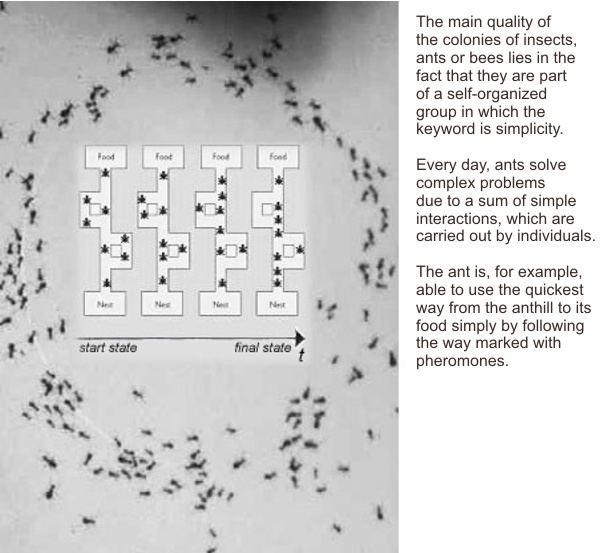 | ||
Artificial ants
In computer science, Artificial Ants stand for multi-agent methods inspired by the behavior of real ants. The pheromone-based communication of biological ants is often the predominant paradigm used. Combinations of Artificial Ants and local search algorithms have become a method of choice for numerous optimization tasks involving some sort of graph, e. g., vehicle routing and internet routing. The burgeoning activity in this field has led to conferences dedicated solely to Artificial Ants, and to numerous commercial applications by specialized companies such as AntOptima. As an example, Ant colony optimization is a class of optimization algorithms modeled on the actions of an ant colony. Artificial 'ants' (e.g. simulation agents) locate optimal solutions by moving through a parameter space representing all possible solutions. Real ants lay down pheromones directing each other to resources while exploring their environment. The simulated 'ants' similarly record their positions and the quality of their solutions, so that in later simulation iterations more ants locate better solutions. One variation on this approach is the bees algorithm, which is more analogous to the foraging patterns of the honey bee, another social insect.
Contents
The inventors are Frans Moyson and Bernard Manderick. Pioneers of the field include Marco Dorigo, Luca Maria Gambardella.
For more details, see the page of the paradigm Ant Colony Optimization
Ambient networks of intelligent objects
New concepts are required since “intelligence” is no longer centralized but can be found throughout all minuscule objects. Anthropocentric concepts have always led us to the production of IT systems in which data processing, control units and calculating forces are centralized. These centralized units have continually increased their performance and can be compared to the human brain. The model of the brain has become the ultimate vision of computers. Ambient networks of intelligent objects and, sooner or later, a new generation of information systems which are even more diffused and based on nanotechnology, will profoundly change this concept. Small devices that can be compared to insects do not dispose of a high intelligence on their own. Indeed, their intelligence can be classed as fairly limited. It is, for example, impossible to integrate a high performance calculator with the power to solve any kind of mathematical problem into a biochip that is implanted into the human body or integrated in an intelligent tag which is designed to trace commercial articles. However, once those objects are interconnected they dispose of a form of intelligence that can be compared to a colony of ants or bees. In the case of certain problems, this type of intelligence can be superior to the reasoning of a centralized system similar to the brain.
Nature has given us several examples of how minuscule organisms, if they all follow the same basic rule, can create a form of collective intelligence on the macroscopic level. Colonies of social insects perfectly illustrate this model which greatly differs from human societies. This model is based on the co-operation of independent units with simple and unpredictable behavior. They move through their surrounding area to carry out certain tasks and only possess a very limited amount of information to do so. A colony of ants, for example, represents numerous qualities that can also be applied to a network of ambient objects. Colonies of ants have a very high capacity to adapt themselves to changes in the environment as well as an enormous strength in dealing with situations where one individual fails to carry out a given task. This kind of flexibility would also be very useful for mobile networks of objects which are perpetually developing. Parcels of information that move from a computer to a digital object behave in the same way as ants would do. They move through the network and pass from one knot to the next with the objective of arriving at their final destination as quickly as possible.
Artificial Pheromone System
Pheromone-based communication is one of the most effective ways of communication which is widely observed in nature. Pheromone is used by social insects such as bees, ants and termites; both for inter-agent and agent-swarm communications. Due to its feasibility; artificial pheromones have been adopted in multi-robot and swarm robotic systems. Pheromone-based communication was implemented by different means such as chemical or physical (RFID tags, light, sound) ways. However, those implementations were not able to replicate all the aspects of pheromones as seen in nature.
Using projected light was presented in is an experimental setup to study on pheromone-based communication with micro autonomous robots. Another study that proposed a novel pheromone communication method,COSΦ, for a swarm robotic system based on precise and fast visual localization. The system allows to simulate virtually unlimited number of different pheromones and provides the result of their interaction as a gray-scale image on a horizontal LCD screen that the robots move on. In order to demonstrate the pheromone communication method, Colias autonomous micro robot was deployed as the swarm robotic platfrom.
